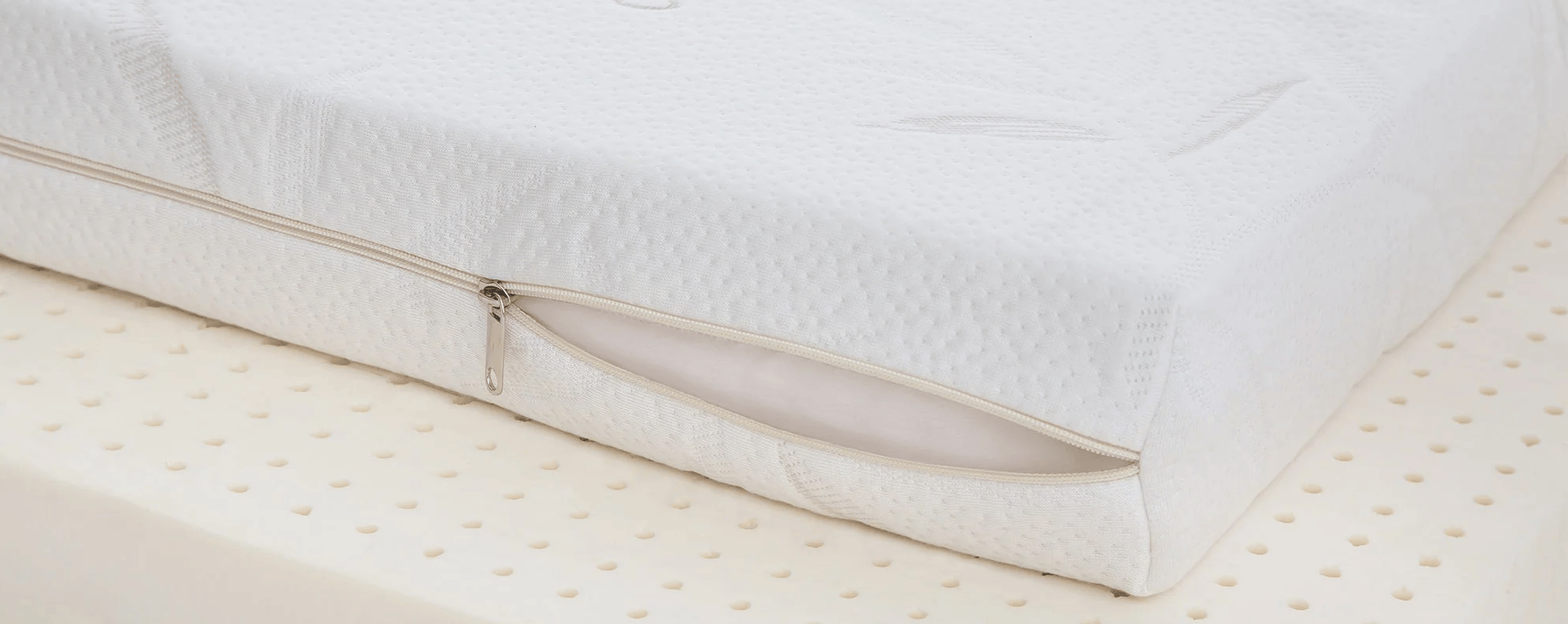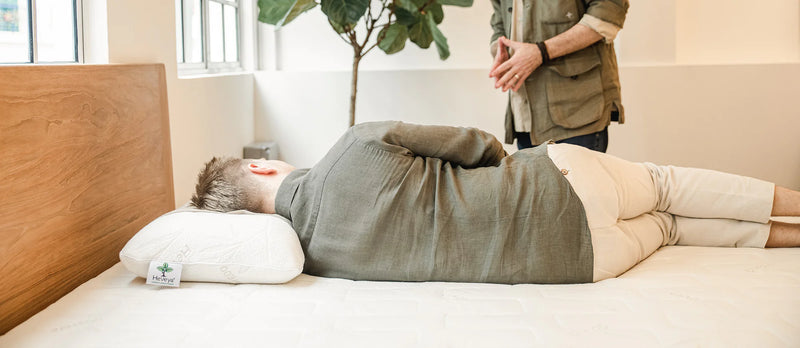Feeling a bit lost navigating the world of latex mattresses? You’re certainly not alone. Terms like blended, natural, organic, Dunlop, and Talalay get thrown around a lot, so it’s worth clarifying what they mean when you’re trying to find the best bed for a good night’s sleep
You might be wondering what the differences are between these types of latex? Does it really affect sleeping comfort or how soundly you sleep? And why do some types cost quite a bit more? These are really good questions, and it's easy to feel a bit lost with all the options.
Right then, let’s make it clear! This guide will simply explain the differences between blended, natural, and organic latex. We'll also explain what processing methods like Talalay mean for comfort, and introduce you to Dunlop, the method Heveya® mattresses are created from. The aim? To give you the knowledge you need to choose wisely, without the confusing technical jargon.
Before We Dive In: What Actually is Latex Foam Anyway?
Before comparing the labels, let's quickly touch on the basics. What is this bouncy stuff we call latex foam?
Ever wonder where latex mattresses come from? It starts as a milky white liquid sap tapped right out of rubber trees, called Hevea brasiliensis. This natural sap is the key ingredient for that bouncy mattress foam, and it's gathered responsibly, mainly in warmer parts of the world.
Of course, raw tree sap isn't mattress-ready. It needs processing. The liquid latex is mixed with curing agents and then baked in a mould. This process, called vulcanisation, turns the liquid into the stable, elastic foam used in bedding.
So, why do people enjoy latex mattresses? Latex foam boasts several great natural properties:
•Unique Buoyancy: It offers a springy, responsive feel, pushing back gently for support without that 'stuck' feeling some foams give.
•Excellent Support & Pressure Relief: It moulds to your body, helping keep your spine aligned while cushioning pressure points like hips and shoulders.
•Durability: High-quality latex, especially natural and organic types, is incredibly resilient and can last for many years (think 15-20+) without sagging.
•Breathability: Its natural open-cell structure lets air circulate, helping dissipate heat and moisture for a cooler sleep compared to many synthetic foams.
Now that we've got the basics, let's tackle those potentially confusing labels.
Unpacking the Labels: Blended vs Natural vs Organic Latex Explained
Understanding these terms helps you know what you’re really buying when looking at latex mattress types.
Blended Latex: The Budget-Friendly Mix
First up is blended latex. As the name implies, it’s not purely from the rubber tree.
What it is: Basically, it's a blend. It mixes some natural latex (from rubber trees) with man-made latex. The man-made bit is usually a type called SBR, which is based on petroleum (like oil products). The amounts in the mix can vary quite a lot; some have loads of man-made stuff, others are closer to half natural, half man-made (like 50/50), or even mostly natural.
Why it exists: The primary purpose of blended latex is to balance cost with performance. High-quality natural latex is more expensive and has a fluctuating supply. By combining it with a more cost-effective synthetic latex, manufacturers can ensure steady production and offer mattresses at a more accessible price point.
Pros: Generally the most affordable latex option; can still offer some latex bounce; potentially consistent feel.
Cons: Less natural material means fewer pure latex benefits (like breathability); contains petroleum chemicals; potential for more initial off-gassing smells; reduced durability, as cheap 'fillers' like chalk are often added, causing the mattress to deteriorate much faster.
Key Takeaway: A blended latex mattress mixes natural and man-made materials, mainly for affordability. It’s a compromise.
Natural Latex: Straight from the Tree (Almost!)
A significant step towards a plant-based option.
What it is: This foam is made almost entirely from rubber tree sap. It's the go-to for those wanting a more natural sleep surface without needing full organic certification.
Clarification - The Small Print
Turning sap into foam requires a few processing aids (like curing agents). This means 'natural' latex isn't 100% pure sap in the end. However, quality natural latex must contain at least 95% natural rubber. Be wary of vague labels like "made with natural latex" – true natural latex shouldn't be a blend.
Pros: Much more eco-friendly than blended (uses a renewable resource); offers fantastic natural elasticity, support, and bounce; highly durable; naturally breathable for cooler sleep; less potential for chemical smells; naturally hypoallergenic (resists dust mites/mould).
Cons: Costs more than blended latex due to harvesting/processing expenses; the term "natural" isn't as strictly regulated as "organic," so quality can vary (look for transparency!).
Important Note: Remember, natural vs organic latex are distinct. Natural latex comes from nature but doesn't automatically meet strict organic standards. Let's look at that now.
Organic Latex: The Top Tier for Purity and Peace of Mind
This is the premium standard, focusing on purity, health, and environmental care.
What it is: Organic latex is natural latex, but produced under much stricter, certified guidelines from farm to factory.
How it's Different – The Journey Matters:
The Farm: Rubber trees must be grown on plantations following rigorous organic farming standards – absolutely no synthetic pesticides, herbicides, or chemical fertilisers. This promotes biodiversity, protects the environment, and ensures the raw sap is purer.
The Factory: Processing the sap into foam also meets strict organic criteria, often limiting processing agents and favouring safer alternatives, alongside eco-sound manufacturing.
The Proof: Genuine organic latex requires certification. The most recognised global standard is GOLS (Global Organic Latex Standard). Look for this logo! It guarantees the latex meets strict environmental/social criteria and contains at least 95% certified organic raw latex. Other labels like eco-INSTITUT (low emissions) can complement GOLS.
Quick Fact: GOLS certification covers latex purity and fair labour practices plus responsible wastewater treatment.
Pros: Highest purity, minimising chemical exposure (ideal for sensitivities); most eco-friendly, supporting sustainable practices; exceptional durability and comfort; biodegradable; provides peace of mind via verifiable certification (GOLS).
Cons: Typically the most expensive type due to stringent requirements, certification costs, and often higher farming expenses.
Key Takeaway: Organic latex (especially GOLS certified) is the premium choice for health, eco-consciousness, and verified purity. You pay more for the highest standard.
What About "Talalay"? Demystifying the Latex Making Process
You often see "Talalay" mentioned Natural Talalay Latex, Organic Talalay Latex. What does that signify?
Crucially, Talalay is NOT a type of latex material.
Think of baking again. You have your flour (latex source: natural or organic). Then you choose how to bake – a standard oven or maybe a fancy steam method. Talalay is one of those methods.
Dunlop and Talalay: Understanding the Latex Making Process
You will often see the terms "Dunlop" and "Talalay" used when discussing latex. It's crucial to know that these are not types of latex material, but rather the two primary manufacturing processes used to create the foam. Think of it like cooking: You start with the same high-quality ingredient (natural latex sap), but use a different recipe to achieve a unique result.
At Heveya®, we have proudly chosen the time-tested Dunlop method to create our mattresses. Let's explore both processes.
The Dunlop Process (The Heveya® Method)
The Dunlop process is the original, classic method for creating latex foam. Its elegant simplicity results in a mattress that is naturally supportive, resilient, and extremely durable.
What the Dunlop Process Achieves (The Feel & Performance):
The Talalay Process
The Talalay process is a more complex, multi-stage method.
•Partial Fill & Vacuum: The mould is only partially filled with latex, then sealed and vacuumed. This expands the latex to fill the entire mould, making it feel more uniformed.
•Flash Freezing: The expanded foam is flash-frozen, which locks an open, interconnected cell structure in place.
•Vulcanisation (Baking): The frozen block is then baked to cure the foam.
What the Talalay Process Achieves (The Feel & Performance):
•Softer & Bouncier: Due to the air infused by the vacuum and freezing steps, Talalay often feels lighter and more buoyant than Dunlop of a similar firmness.
•Consistent Cell Structure: The process creates a very uniform cell structure from top to bottom.
Putting It All Together
Both Dunlop and Talalay can be used to process natural or organic latex sap. An "Organic Talalay" mattress uses organic sap with the Talalay method, while a "Organic Dunlop" mattress uses organic sap with the Dunlop method.
Heveya®'s choice to use the Dunlop process is a deliberate one, focused on delivering a mattress with unparalleled support, proven durability, and a more eco-efficient production footprint.
Why the Price Difference? Is Organic Latex Worth It?
You've seen the price pattern: Blended is cheapest, Natural mid-range, Organic is premium. Why? And crucially, is organic latex worth it?
Let's break down costs:
•Blended: Cheapest due to lower synthetic material costs.
•Natural: More expensive due to labour-intensive harvesting/transport/processing of rubber sap.
•Organic: Most expensive due to: stricter organic farming (often lower yields, higher labour); costly GOLS certification (audits, compliance); potentially segregated processing needs; the premium paid for verified purity.
•Talalay Process: More complex and energy-intensive than Dunlop, adding cost regardless of latex source.
So, Is Organic Talalay Worth the Extra Spend?
1. The "Organic" Component (The Source & Purity)
This is what the GOLS (Global Organic Latex Standard) certification guarantees. It focuses on health and environmental impact.
•Source: The rubber tree sap is harvested from plantations that do not use chemical pesticides or herbicides.
•Purity: The processing of the sap into foam is done without harmful chemicals, ensuring the final product is as pure and non-toxic as possible.
•Benefit: Peace of mind for health (ideal for those with chemical sensitivities), and a more sustainable, eco-friendly product.
2. The "Talalay" Component (The Feel & Performance)
This is a sophisticated, multi-step manufacturing process that creates a specific type of latex foam. It's often contrasted with the simpler Dunlop process.
•Process: The mold is only partially filled with latex, which is then expanded by a vacuum to fill the space. It is flash-frozen to lock in an open-celled structure, and then baked (vulcanized).
•Resulting Feel: This creates a remarkably consistent, "buoyant," and cloud-like foam. It feels softer and offers more contouring pressure relief than Dunlop of the same firmness level.
•Key Benefit:
•Superior Pressure Relief: Excellent for side sleepers and those with shoulder or hip pain.
•Unmatched Breathability: The flash-freezing step creates a very open and consistent cell structure, allowing for maximum airflow. Talalay is widely considered the most breathable and cool-sleeping latex available.
Making Your Choice: A Quick Cheat Sheet for Latex Types
Feeling clearer? Here’s a simple guide:
| Feature | Blended Latex | Natural Latex | Organic Latex (GOLS Certified) |
|---|---|---|---|
| Source | Mix: Natural + Synthetic (SBR) | Mostly Rubber Tree Sap (>95%) | Certified Organic Rubber Tree Sap (>95%) |
| Purity | Contains Petrochemicals | High Natural Content | Highest Purity, Verified |
| Eco-Friendly | Least | Good (Renewable Resource) | Best (Sustainable Farming) |
| Health Focus | Lower | Good (Hypoallergenic) | Best (Minimal Chemicals) |
| Feel | Varies; Can be less 'latex-like' | Good | Excellent |
| Breathability | Okay to Good | Good | Excellent |
| Durability | Good | Good | Excellent |
| Certification | Good | Quality varies | GOLS is the key standard |
| Price | (Most Affordable) | (Mid-Range) | (Premium) |
Remember the Process:
•Talalay Process: Generally softer, bouncier, more breathable. Often for comfort layers. Adds cost.
•Dunlop Process: Generally denser, firmer, more supportive. Often for support cores. Less expensive process.
The most crucial decision is not what you can afford today, but what offers the best value over 20 years. Therefore, the first step should be to commit to a high-quality, durable mattress built to last. Only after making this foundational decision should you refine your selection by considering the source material (like the certified purity of Organic) or the specific feel offered by the Talalay and Dunlop processes.
Your Path to Truly Restorative Sleep: The Heveya® Natural Organic Latex Mattress
Thinking that pure, healthy, and comfy organic latex sounds right for you? We agree! We're passionate about how nature helps us sleep well. That’s the reason the Heveya® mattress is carefully made with certified natural organic latex.
Choosing Heveya® means choosing:
•Pure & Healthy Sleep: Certified organic latex and natural materials mean no harmful pesticides or unnecessary chemicals. Better for you, kinder to the planet.
•Tailored Comfort & Support: Organic latex is both soft for comfort and supportive enough to keep your spine nicely lined up while you sleep.
•Naturally Cool & Breathable: The open-cell latex structure plus natural covers promote airflow, helping regulate temperature for undisturbed sleep.
•A Durable Investment: Organic latex is highly durable, long-lasting and offers a comfortable sleep.
•Naturally Hypoallergenic: It naturally keeps dust mites and mould away, which is great for allergy sufferers and means a cleaner bedroom.

Buying a Heveya® Natural Organic Latex Mattress isn't just getting a bed, it's choosing deeper, more refreshing sleep and creating a healthier space for yourself. Investing in a Heveya® Natural Organic Latex Mattress is more than buying a bed; it's choosing deeper, restorative sleep and creating a healthy sanctuary. For our customers in Hong Kong, you can also explore our showroom at 28/f Horizon Plaza, Ap Lei Chau (Located in TREE's Flagship Store).
Ready for a Naturally Better Night's Sleep?
Experience the pure comfort, support, and peace of mind of a Heveya® Natural Organic Latex Mattress. Discover the difference quality materials make.
Conclusion: Choosing Your Perfect Latex
So, that's the main takeaway on Blended, Natural, and Organic Talalay Latex. Hopefully, it all makes more sense now! Just remember the basics: Blended is a mix, often about saving money. Natural comes mostly from trees and works really well. Organic offers top purity and is best for the planet. And Talalay is simply how it's made, usually giving a softer, bouncier feel than the firmer Dunlop method.
Knowing this helps you ignore the confusing ads and pick the mattress that's truly right for you, what you like, what you can spend, and what matters most to you. Choosing a comfy mattress is genuinely looking after your health. Sleep well!














